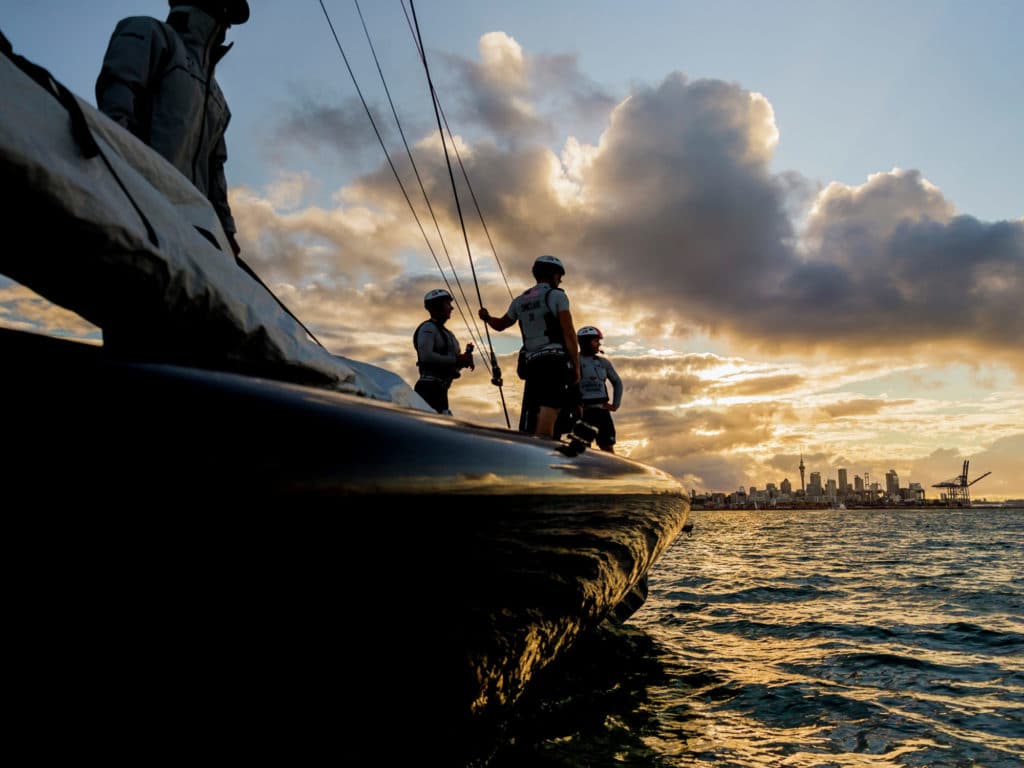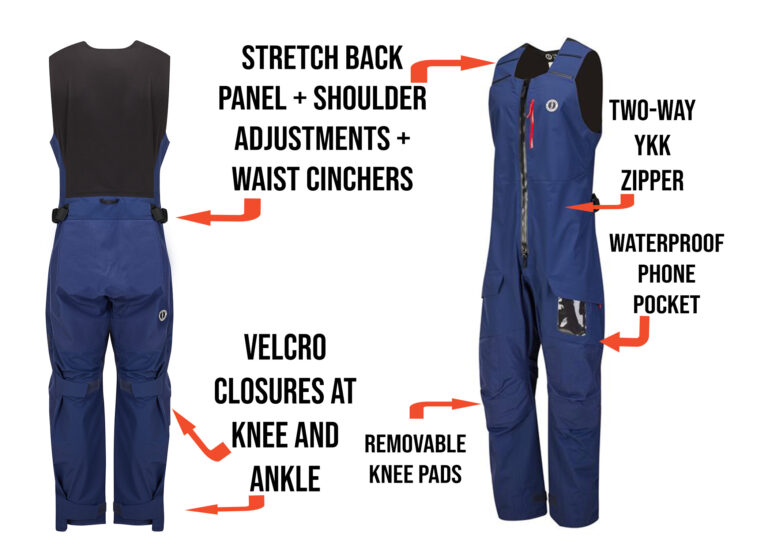
To take my call from the opposite hemisphere, American Magic sailing team member Matt Cassidy steps outside into the open air at the team’s base, for better reception over his cellphone’s 3G connection. He doesn’t have the Spark 5G service enjoyed by the sailors of Emirates Team New Zealand across the way. Chalk this one up as yet another advantage for the Defender. But no matter, because outside, it’s a beautiful day in Auckland. It’s a warm summer morning, there’s no COVID, and it’s a boat maintenance day—exactly one week out before the first race of the Prada Cup Challenger Selection Series. Until the New York YC team’s first lineup with INEOS Team UK on January 15, Cassidy, the 42-year-old grinder from Harbor Springs, Michigan, has one primary task: stay healthy and be ready to give it his all if he’s tapped in to hit the handles.
Cassidy, who is assigned to the grinding pedestal with skipper, executive director and tactician Terry Hutchinson, Cooper Dressler and Jim Turner, says the shore team now has full responsibility for preparing the AC75 Patriot. “Right now, for us, it’s just about going to the gym, maintaining strength and staying healthy and injury free,” Cassidy says. “Our shore team roles are relaxed a bit so we can be as fit as we can for the racing.”
Truth be told, Cassidy has yet to sail a race in this 36th edition of the America’s Cup. With a quicker-than-expected turnaround between races at the Prada America’s Cup World Series in December the team did not rotate in fresh grinders as planned, but he was happy to be on standby and watch his teammates deliver a strong performance to finish second to Emirates Team New Zealand.
“The guys who did the first race were better off just staying in,” he says, “because it wasn’t as exhausting as we anticipated. Our training days were much harder than the race days. Two 25-minute races are nothing compared to the four to six hours on the water each day of training.”
Keen observers may have noticed that Hutchinson wasn’t onboard Patriot for all the races of the World Series either. A stomach bug that worked its way through Auckland allegedly hit Hutchinson hard, serving as a reminder to all the importance of hygiene and sanitation, says Cassidy, especially as the competition ramps up and sailors and shore team members alike wear themselves down.
“Even though there is no COVID here, there are other things that can take a team down,” Cassidy says. “It’s a tight-knit group, and if someone gets sick, it can take out 20 people, so it’s a team-wide philosophy to rest, take vitamins and do whatever we can to boost our immune system because no one can afford to have anyone sick right now.”
That said, the full-press effort in all corners of the American Magic base has been relentless since the America’s Cup World Series concluded. In the two days immediately following the regatta, Cassidy says, the sailing team logged two seven-hour days before finally putting the boat in the shed for its Christmas work list. While the sailors recovered, the shore team worked their magic.
The boat is a constant evolution, he says. It will never be the same on any given day. For example, the obvious visual change when Patriot returned to the water was the extension of its skeg.
“That’s purely an end-plating thing,” Cassidy says. “When we looked at our ride height and the angles we sail, there was a bit of a gap at the back so we just dropped it down a bit to seal it better. The more you seal the sails to the hull, to the water, the better it is. That’s been on the list for a while and we had a little window after racing to do it.”
It was obvious to fans and broadcast viewers that the team struggled at times during a few of the World Series races, maring an otherwise excellent outing and denying them a regatta win. “We did some foil changes prior to the regatta,” Cassidy says, “but it’s not as simple as putting a new set of foils on and going out to sail the boat. They’re different, so your settings are different and your numbers are different—it takes time to get used to them. Our two losses were unforced errors on our part.”
Two flubbed maneuvers weren’t the result of a foil-design flaw or mechanical issue with the foil control system, the likes experienced by INEOS Team UK. They were boathandling errors Cassidy says. A closer look at the video and data pointed to technique—a problem easily rectified once they resumed training after the Christmas break.
“I think we’ve made pretty good gains from how we are sailing the boat now,” Cassidy says. “We have more confidence in our maneuvers. We know we have to be perfect. We can’t fall off the foils. One bad tack is 100 meters lost in a matter of 5 seconds, and once you’re behind, it’s pretty hard to pass.”
Satisfaction with the World Series result is one thing, but not a single America’s Cup sailor in Auckland, gives much weight to the results of 2020. It’s ancient history.
“We’re definitely happy, but we can’t sit back and say we are fast,” Cassidy says. “Our maneuvers were good 90 percent of the time, but we need 100 percent, and as much as we’re progressing, others are as well. The difference between right and wrong is not much. A few tweaks here and there add up to a few knots of boatspeed.”
Cassidy says American Magic did have their issues with the supplied foil control system early on, but they’ve since identified problem areas and components and been hyper-focused on ensuring reliability throughout the system, and staying ahead of the constant maintenance.
“Our focus is to not lose sailing days or races because of a breakdown,” he says. “The boards go up and down fine, but it’s like any foiling boat; if you drop the board at the wrong angle, they stall out, wash out and you crash down. It’s a balancing act between the two foil arms, the foil and the rudder, and Andrew [Campbell] is trying to balance all that. It’s a turn rate thing, an angle thing, ride height and so on. There are so many variables.”
In the days leading up to Friday’s Prada Cup races, the respective recon teams have been busy as boats and techniques are evolving daily, as is the equipment. They’re watching and they’re most certainly being watched—very closely. “The recon guys are looking at everything, day in and day out, and they know what other teams are changing,” Cassidy says.
American Magic has Finn Olympic bronze medalist Caleb Paine glued to its competitors, in particular Emirates Team New Zealand. “Anyone [on the team] who wants to can go look at his recon files,” Cassidy says. Designers, sailmakers, engineers and sailors alike can monitor each team’s advancements and decide whether to explore or leave be. “You have to stay up with what the other guys are doing because every day the boats change.”
Looking ahead to the challenger selection races, Cassidy acknowledges that the general sentiment around the harbor is that Luna Rossa is fast at both ends of the wind range and INEOS Team UK should most definitely not be dismissed. “Everyone around here knows that’s not the team that’s going to show up and go racing,” Cassidy says. “They will come out firing for this challenger series. Over the past few days, they’ve been going very well. It’s a totally different boat now.”
Which, of course, speaks to the continuum of development that’s happening with renewed urgency across all bases. That’s the name of the game: developing 24/7, and from here on out, sailing every race as if it’s the last. “Everyone is anxious to see what happens when the boats really line up,” Cassidy says. “We know we have good wheels right now, but the other guys have them as well.”









